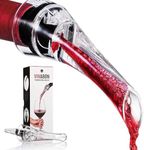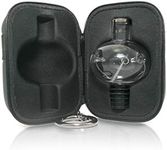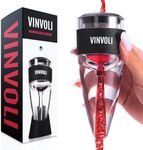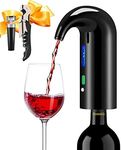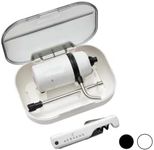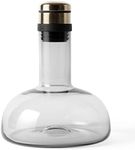Buying Guide for the Best Wine Aerators
Choosing the right wine aerator can make a noticeable difference in how your wine tastes and smells. Aerators work by exposing wine to air, which helps to release its aromas and soften its flavors. The best aerator for you depends on how you like to enjoy your wine, how much convenience you want, and how often you plan to use it. Understanding the key features will help you pick an aerator that fits your needs and enhances your wine experience.Type of AeratorThe type of aerator refers to the design and method it uses to introduce air into the wine. There are handheld pour-through aerators, in-bottle aerators, and decanter-style aerators. Handheld pour-through aerators are used as you pour wine through them into your glass, offering quick results and easy use. In-bottle aerators fit directly onto the bottle and aerate as you pour, making them convenient for serving multiple glasses. Decanter-style aerators require you to pour the wine into a separate vessel, which can be more time-consuming but often provides a more thorough aeration. If you want speed and simplicity, a pour-through or in-bottle aerator is ideal. If you enjoy the ritual and have time, a decanter-style might suit you better.
MaterialWine aerators are commonly made from plastic, glass, or stainless steel. Plastic aerators are lightweight and affordable, but may not be as durable or attractive. Glass aerators look elegant and don’t affect the taste, but they can be fragile. Stainless steel aerators are sturdy and often have a modern look, but can be heavier. If you want something durable for frequent use, stainless steel or high-quality plastic is a good choice. For special occasions or display, glass might be more appealing.
Ease of CleaningEase of cleaning is about how simple it is to keep your aerator hygienic and ready for use. Some aerators have multiple parts or narrow channels that can trap wine residue, making them harder to clean. Others are dishwasher-safe or have a simple design that rinses easily. If you plan to use your aerator often, look for one that is easy to take apart and clean, or that is labeled as dishwasher-safe. This will save you time and ensure your wine always tastes fresh.
Flow ControlFlow control refers to how the aerator manages the speed and amount of wine being poured. Some aerators have adjustable settings or built-in mechanisms to control the flow, which can help prevent spills and allow you to customize the aeration process. Others have a fixed flow, which is simpler but less flexible. If you like to experiment with different wines or want to avoid mess, an aerator with flow control features can be helpful. For straightforward use, a fixed-flow aerator is usually sufficient.
PortabilityPortability is about how easy it is to take the aerator with you or use it in different settings. Smaller, lightweight aerators are easy to bring to parties, picnics, or restaurants, while larger or more delicate models are better suited for home use. If you often enjoy wine outside your home or want to share the experience with friends, choose a compact and sturdy aerator. If you mostly drink wine at home, portability may be less important.




